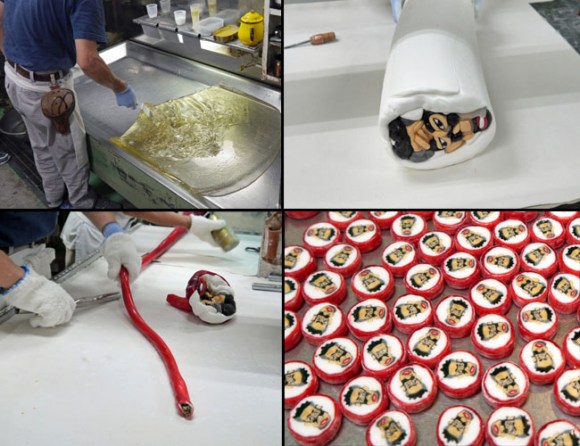
Sadly, they refused to make them taste like Mr. Sato.
My-Ame is a confectioner that has gained worldwide fame for their detailed versions of Kintaro Ame — small candies that have shapes or words molded into them. This type of candy has been around for quite some time, but My-Ame has built up a special reputation since their establishment in 2007 by global word of mouth.
Then, a video of their production techniques went viral for the incredibly satisfying sensations it produced and netted over five million views.
After that, My-Ame was again in the spotlight after allegations that Daivd Beckham’s son had stood them up on an order for 3,500 candies with the initials “BB.”
Despite that minor setback, business has been booming for these craftsmen with thousands of orders flooding into their Nagoya-based studio from companies, schools, and individuals. So we thought, “why not one more?”
Mr. Sato, who had been in contact with My-Ame during the Brooklyn Beckham debacle, decided to once again place a call, but this time to make an order of 3,500 candies featuring his own face!
He sent a photo of himself to My-Ame and they worked together to choose a design that both captured his highly featured face and could be practically made into a candy. After a few back-and-forth emails, they had reached a compromise.
Mr. Sato also asked to be present during the making of his candies, to which My-Ame generously agreed.
Inside the My-Ame workshop, a team of experienced candy artisans carefully planned the making of the Mr. Sato candies.
It was here Mr. Sato realized that despite the relaxing videos, this procedure is actually quite nerve-racking. The candy needs to be at just the right temperature to work with, leaving only a relatively short window of time to complete it and zero room for error.
This meant the team would have to work together seamlessly like the gears of a watch. Mr. Sato observed them do so with a certain non-verbal communication that only comes with a high degree of skill and experience.
Next, Mr. Sato was called over to the kettle where his candy was currently boiling at 150 degrees Celsius (302 degrees Fahrenheit).
Below the pot is a wide flat metal sheet which cools the mixture.
However, only the metal part cools the candy, so they have to constantly move it around to lower the temperature evenly as seen in the famous video.
The next step involves adding the flavor. There are 12 “standard” flavors to choose from such as strawberry, lemon, or melon. Then there are also 15 “unusual” flavors like cola or coffee. Since you can also mix flavors, there are a lot of options for buyers.
Mr. Sato choose “strawberry milk” for his candy solely because it would be the flavor one would least expect while sucking on his face.
Then the candy is separated and colored. Dye is added to achieve deep and dark colors, but by stretching the candy by hand or machinery, exposure to the air will lighten the hues.
Bit by bit each component of Mr. Sato’s face is assembled. Red and white candy make his mouth…
…white, black, and a skin tone make his eyes…
…and all the individual features are made. It is intricate work, but also a race against the clock, and everything needs to be assembled before the candy cools and hardens.
From here we can see the basic form of Mr. Sato’s head take form. It sort of looks as if our reporter guest-starred on a California Raisins special, broadcast live from the event horizon of a black hole.
Next, the negative space had to be filled in by adding a circular coating of white candy.
With that, Mr. Sato’s face really starts to stand out.
The final layer is the red boarder which is wrapped around the outside of this gigantic candy log.
From there it is loaded into a machine that rotates and stretches it, but the candy looked so huge, Mr. Sato couldn’t imagine this being an easy process.
Nevertheless, the artist began manipulating the end of the candy.
Rather quickly but carefully he began pulling it outward into a much thinner tube.
And just like that, it stretched right out, much easier than Mr. Sato thought it could.
As the candy gets pulled out, it is cut into 20-centimeter (eight-inch) rods.
These tubes are then fed into a machine that slices them into one-centimeter (0.4-inch) candy discs. Quality control is also done at this point to remove any misshapen ones.
And in the end we have a seas of tiny Mr. Sato’s… 3,500 of them to be exact.
At a glance each one looks identical, but because of the twisting and stretching there are slight variations in each face.
Why, this one looks just like the time Mr. Sato ate 350 slices of cheese.
All that was left was to individually wrap all 3,500 candies. Thankfully that part wasn’t done by hand.
From boiling kettle to wrapper the entire process took between 30 and 40 minutes. We condensed it all down to a six-and-a-half-minute video for your pleasure.
It’s an impressively fast feat that must require a considerable amount of knowledge and practice to be able to pull off.
However, the final challenge went to Mr. Sato: what to do with several thousand candies featuring his face?
It’s times like these that Mr. Sato is extremely glad he has a twin brother. As for the remaining thousand or so, since they have an expiry date one year later, the birthdays of everyone Mr. Sato ever knew will be covered well into 2018.
Special thanks to My-Ame
Photos and video: ©SoraNews24
[ Read in Japanese ]